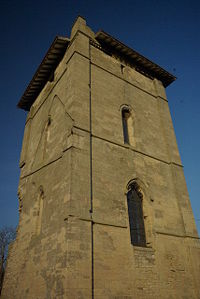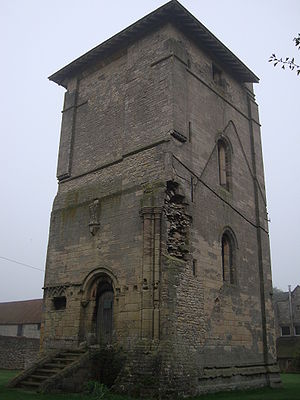
Temple Bruer
Encyclopedia
Temple Bruer is in a farm-yard in the civil parish of Temple Bruer with Temple High Grange, England. It is one of the few Knights Templar
sites left in England where any ruins remain standing. Its name comes from its Templar ownership and its position in the middle of the Lincoln Heath, bruyère (heather) from the French language current at the time. It was founded in the period 1150 to 1160 and the order was dissolved in 1312.
It is at grid reference , in Lincolnshire
, England
located between the A15 and A607 roads, north of Cranwell
. The site has been excavated twice, once in Victorian times and again at the start of the 20th Century.
 The Templars were suppressed at a time when England
The Templars were suppressed at a time when England
was on the brink of economic disaster. However, the great change in emphasis from arable to sheep farming was part of the recovery from that disaster. The lifetime of the Templars was one in which the climate allowed expansion. This was the period when villages were set up on uplands and fens, villages which became what we know as deserted medieval village
s.
Nonetheless, much wool
was grown on the Lincolnshire uplands, the Wolds
and the Heath
. That wool was sold through Boston
to Flanders
and woven into cloth. At Temple Bruer, the Templars were leaders in the sheep farming industry, an economic powerhouse that made Lincolnshire a rich county at the time, breeding Lincoln Longwool
sheep. This was a period when Lincolnshire was populous
and an economically
leading part of England.
The economic growth broadly coincided with the decline in the reason for the Templars’ existence. The heyday of the Crusades
was over and people’s thinking had moved on. But the Templars’ wealth remained. They developed into banking. Some potentates were reluctant to repay monies borrowed and a general jealousy of the Templars’ wealth developed.
The community at Temple Bruer was broken up on 10 January 1308 when Edward II
sent knights to arrest the monk-knights for alleged crimes, of which none of significance was substantiated. Nonetheless, the Templars in general were too wealthy and kings, particularly Philip IV of France
owed them too much money for the order to survive and it was suppressed in 1312 by Pope Clement V
.
Beresford and Hurst listed Bruer as a Deserted Medieval Village
in their definitive work, but it is not clear that there was a separate existence as a village.

About 50 yards (45.7 m) away from the tower, on a farm track passing the site, is a curious structure, a column about 25 feet (7.6 m) high, about 18 inches by 18 inches (457.2 mm) at the base, made of some sort of stone, and with small drawers inset. The column tapers as it goes up, and the drawers get progressively smaller, up to about the 7 feet (2.1 m) mark. The drawers will pull open.
This is a sculpture of concrete, steel and wood. It is not very old, and unconnected with the Templar site
Knights Templar
The Poor Fellow-Soldiers of Christ and of the Temple of Solomon , commonly known as the Knights Templar, the Order of the Temple or simply as Templars, were among the most famous of the Western Christian military orders...
sites left in England where any ruins remain standing. Its name comes from its Templar ownership and its position in the middle of the Lincoln Heath, bruyère (heather) from the French language current at the time. It was founded in the period 1150 to 1160 and the order was dissolved in 1312.
It is at grid reference , in Lincolnshire
Lincolnshire
Lincolnshire is a county in the east of England. It borders Norfolk to the south east, Cambridgeshire to the south, Rutland to the south west, Leicestershire and Nottinghamshire to the west, South Yorkshire to the north west, and the East Riding of Yorkshire to the north. It also borders...
, England
England
England is a country that is part of the United Kingdom. It shares land borders with Scotland to the north and Wales to the west; the Irish Sea is to the north west, the Celtic Sea to the south west, with the North Sea to the east and the English Channel to the south separating it from continental...
located between the A15 and A607 roads, north of Cranwell
Cranwell
Cranwell is a village situated in the North Kesteven district of Lincolnshire. It is part of the Civil Parish of Cranwell and Byard's Leap and is located 3.95 miles north-north-west of Sleaford and 16.3 miles south-east of the county town of Lincoln...
. The site has been excavated twice, once in Victorian times and again at the start of the 20th Century.
Rise and Fall of the Knights Templar in Lincolnshire
The financing of wars, particularly in places as far away as the holy lands, was an expensive enterprise. The Templars financed their military campaigns through the income generated by their estates all over Europe, including several in Lincolnshire. Most of these served primarily as a means to generate income, but the Temple Bruer estate on the Lincoln Heath (a relatively featureless landscape largely free of trees) was different in that it was particularly suitable for use as a base for the practising of military manoeuvres. It thus became the centre of the Templars’ estates in Lincolnshire.
England
England is a country that is part of the United Kingdom. It shares land borders with Scotland to the north and Wales to the west; the Irish Sea is to the north west, the Celtic Sea to the south west, with the North Sea to the east and the English Channel to the south separating it from continental...
was on the brink of economic disaster. However, the great change in emphasis from arable to sheep farming was part of the recovery from that disaster. The lifetime of the Templars was one in which the climate allowed expansion. This was the period when villages were set up on uplands and fens, villages which became what we know as deserted medieval village
Deserted medieval village
In the United Kingdom, a deserted medieval village is a former settlement which was abandoned during the Middle Ages, typically leaving no trace apart from earthworks or cropmarks. If there are fewer than three inhabited houses the convention is to regard the site as deserted; if there are more...
s.
Nonetheless, much wool
Wool
Wool is the textile fiber obtained from sheep and certain other animals, including cashmere from goats, mohair from goats, qiviut from muskoxen, vicuña, alpaca, camel from animals in the camel family, and angora from rabbits....
was grown on the Lincolnshire uplands, the Wolds
Lincolnshire Wolds
The Lincolnshire Wolds is a range of hills in the county of Lincolnshire, England. It is a designated Area of Outstanding Natural Beauty , and the highest area of land in eastern England between Yorkshire and Kent...
and the Heath
Lincoln Cliff
The Lincoln Cliff is the portion of a major escarpment that runs north-south through Lindsey and Kesteven, in central Lincolnshire and is a prominent landscape feature in a generally flat portion of the county...
. That wool was sold through Boston
Boston, Lincolnshire
Boston is a town and small port in Lincolnshire, on the east coast of England. It is the largest town of the wider Borough of Boston local government district and had a total population of 55,750 at the 2001 census...
to Flanders
Flanders
Flanders is the community of the Flemings but also one of the institutions in Belgium, and a geographical region located in parts of present-day Belgium, France and the Netherlands. "Flanders" can also refer to the northern part of Belgium that contains Brussels, Bruges, Ghent and Antwerp...
and woven into cloth. At Temple Bruer, the Templars were leaders in the sheep farming industry, an economic powerhouse that made Lincolnshire a rich county at the time, breeding Lincoln Longwool
Lincoln (sheep)
The Lincoln, sometimes called the Lincoln Longwool, is a breed of sheep from England. The Lincoln is the largest British sheep, developed specifically to produce the heaviest, longest and most lustrous fleece of any breed in the world. Great numbers were exported to many countries to improve the...
sheep. This was a period when Lincolnshire was populous
Population
A population is all the organisms that both belong to the same group or species and live in the same geographical area. The area that is used to define a sexual population is such that inter-breeding is possible between any pair within the area and more probable than cross-breeding with individuals...
and an economically
Economics
Economics is the social science that analyzes the production, distribution, and consumption of goods and services. The term economics comes from the Ancient Greek from + , hence "rules of the house"...
leading part of England.
The economic growth broadly coincided with the decline in the reason for the Templars’ existence. The heyday of the Crusades
Crusades
The Crusades were a series of religious wars, blessed by the Pope and the Catholic Church with the main goal of restoring Christian access to the holy places in and near Jerusalem...
was over and people’s thinking had moved on. But the Templars’ wealth remained. They developed into banking. Some potentates were reluctant to repay monies borrowed and a general jealousy of the Templars’ wealth developed.
The community at Temple Bruer was broken up on 10 January 1308 when Edward II
Edward II of England
Edward II , called Edward of Caernarfon, was King of England from 1307 until he was deposed by his wife Isabella in January 1327. He was the sixth Plantagenet king, in a line that began with the reign of Henry II...
sent knights to arrest the monk-knights for alleged crimes, of which none of significance was substantiated. Nonetheless, the Templars in general were too wealthy and kings, particularly Philip IV of France
Philip IV of France
Philip the Fair was, as Philip IV, King of France from 1285 until his death. He was the husband of Joan I of Navarre, by virtue of which he was, as Philip I, King of Navarre and Count of Champagne from 1284 to 1305.-Youth:A member of the House of Capet, Philip was born at the Palace of...
owed them too much money for the order to survive and it was suppressed in 1312 by Pope Clement V
Pope Clement V
Pope Clement V, born Raymond Bertrand de Got was Pope from 1305 to his death...
.
Beresford and Hurst listed Bruer as a Deserted Medieval Village
Deserted medieval village
In the United Kingdom, a deserted medieval village is a former settlement which was abandoned during the Middle Ages, typically leaving no trace apart from earthworks or cropmarks. If there are fewer than three inhabited houses the convention is to regard the site as deserted; if there are more...
in their definitive work, but it is not clear that there was a separate existence as a village.

Remaining site
The ruin consists of the intact square south tower of the temple church, one of two added to the original structure during the Templars' tenure, north and south of the chancel. The car park is on the site of the round nave.About 50 yards (45.7 m) away from the tower, on a farm track passing the site, is a curious structure, a column about 25 feet (7.6 m) high, about 18 inches by 18 inches (457.2 mm) at the base, made of some sort of stone, and with small drawers inset. The column tapers as it goes up, and the drawers get progressively smaller, up to about the 7 feet (2.1 m) mark. The drawers will pull open.
This is a sculpture of concrete, steel and wood. It is not very old, and unconnected with the Templar site

